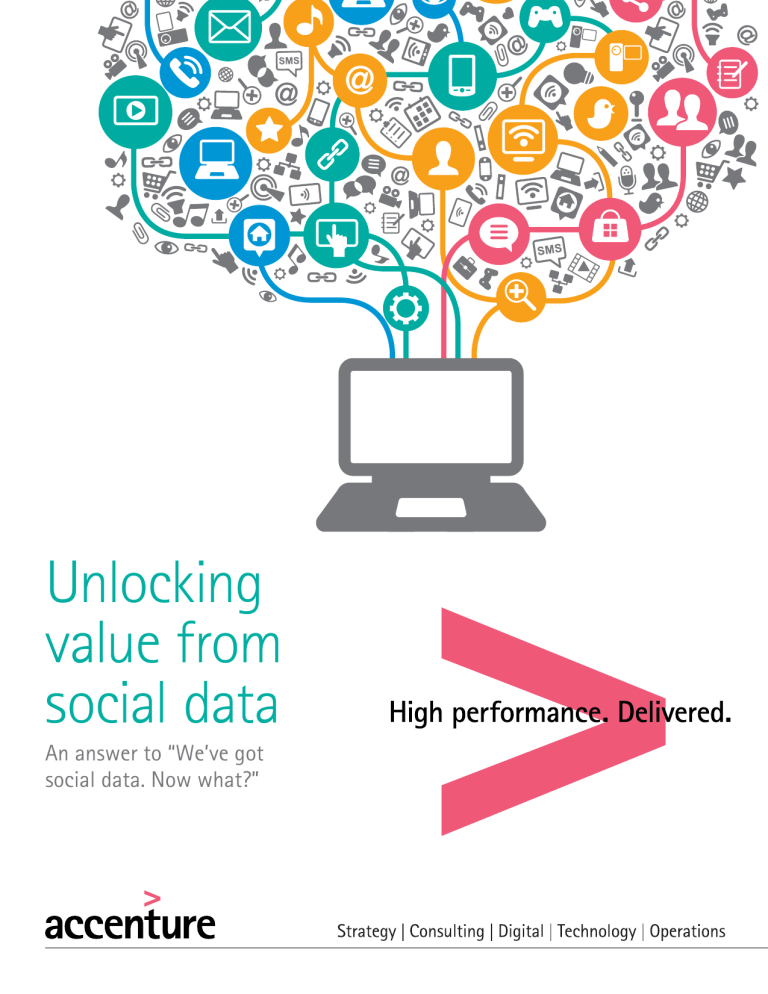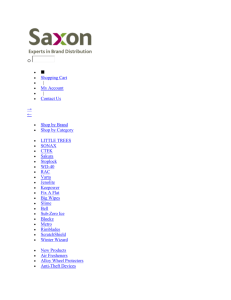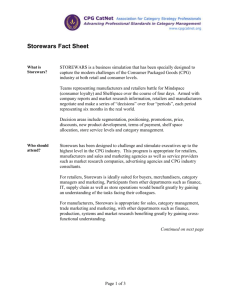Unlocking value from social data

Unlocking value from social data
An answer to “We’ve got social data. Now what?”
2
UNLOCKING
VALUE FROM
SOCIAL DATA
A central problem facing many businesses in various industries today is not a lack of data, but the lack of a clear, actionable plan for what to do with the data. This is particularly the case for social data. During the past few years, the attitude towards social data—especially among consumer-facing companies—has gone from “Social data is just hype,” to “Ok, we have it. Now, what do we do with it?” This document attempts to answer this question, focusing in particular on social data in the context of the retail industry. The approach outlined is applicable and can also be extended to other industries.
The Accenture Technology Vision is rooted in the premise that every business is a digital business. This message hits very close to home in retail, where online retail giants have disrupted the industry by offering convenience of home delivery,
24/7 availability and customer service, easy return policies, and significantly reduced prices. To survive in this competitive environment, high performance retailers have to use cutting-edge technology to strengthen relationships with customers, suppliers and employees, and to leverage the data they collect in innovative ways to improve profitability.
In order to decide how best to use social data, it is necessary to go back to the core of the industry being examined. In the retail industry, the main stakeholders are retailers, customers and suppliers. The only way all stakeholders benefit is if additional value is added to the mix, so that one party does not have to lose for the other to win.
For example, retailers competing through price wars will benefit the customer, but risk hurting their bottom lines. Retailers can use social data to provide additional value, and by doing so, create a win-win situation for customers and suppliers, too.
Most retail companies have established a presence across multiple channels (online, mobile, in stores); many now have an active presence on social media, such as Twitter® or Facebook®, too. Some retailers have even added social plugins on their web sites, giving customers the opportunity to use their social logins, and thus share their social identities. But the next step is still unclear for most retailers. To effectively use all of this social data, retailers need to combine their knowledge of the industry with an understanding of their existing datasets and data analytical tools to determine what sort of questions can be addressed by using data and what sort of data needs to be collected to answer those questions.
One way for retailers to evaluate how to leverage social data is to look at how they have traditionally created value.
Some of the dimensions they have used to distinguish themselves include:
1. Convenience (think 7-Eleven, Inc.,
RedBox Automated Retail, LLC)
2. Product selection (think Wholefoods
Market Inc., JCrew Group, Inc., Zara clothing
Company, Costco Wholesale Corporation)
3. Information and expertise (think
Amazon.com, Inc., and The Best Buy
Company, Inc.)
4. Price and efficiency (think Wal-Mart
Stores, Inc.)
5. Customer service (think Nordstrom, Inc.)
6. Customer segmentation (think Netflix,
Inc., and Sprint Corporation)
Each retailer might be more focused on one or a few of these aspects to create value and differentiate from the competition. In the following sections, we examine each of these possible “pillars of traditional value” and highlight how social data can be embedded to create additional value in each.
3
4
Convenience
Retailers often introduce convenience by addressing the needs of their customers.
These conveniences include being open and available when customers wish to shop, being nearby and accessible to their target customers, and enabling a one-stop shop where possible (e.g., customers can buy fruit, milk, meat and shampoo from the same place, at the same time). More advanced needs include saving customers’ time, enabling them to find what they are looking for easily, or utilizing a network of stores and warehouses to complete quicker delivery.
remind him of the sizes she typically buys, and even offer same day delivery to make sure the gift arrives on time.
Becoming more familiar with customers through their social backgrounds can enable retailers to create a more convenient and enhanced shopping experience by forecasting individual needs and providing a solution. Emerging research 1 suggests that data from social networks (e.g. Foursquare
Labs, Inc. check-ins) can augment traditional methods to predict successful locations for opening up new stores for chains like Starbucks.
In fact, convenience is the main distinctive factor for some retailers. For example, many customers shop at convenient stores or make regular purchases from vending machines, even though the quality might be lower than what they can find elsewhere, the selection is more limited and the price is often higher.
Product selection
Retailers add value by carrying products that match their customers’ needs and tastes.
For example, a customer with a preference for organic food can go to Whole Foods, knowing they will have a wide selection of organic produce, cereals, dairy and more.
Similarly, a price-sensitive customer can go to Walmart confident that he will find products that are priced as expected.
Retailers can use social data to create a more convenient shopping experience for individuals at each step of their shopping journey—from looking for a product, to evaluating various products, to purchasing the product. Here is an example: When a customer based in San Jose, CA, is about to make a purchase and selects his shipping address, the retailer would know the customer’s home city. By accessing the customer’s social profile as well, the retailer can glean from his Facebook® calendar that he is headed to San Francisco for the weekend.
With this data, the retailer could take action if relevant, such as informing the customer that it can ship the item to the hotel where he is staying. And if his Facebook® page indicates he is going to the city to celebrate his anniversary, the retailer could acknowledge the special event, recommend some items his wife has on her wish list,
Product selection at its core is about the width and depth of assortment, brands and quality of products a retailer offers. This selection has a lot to do with addressing the needs of the target market and the brand image of the retailer. The retailer could either add variety to cover a wider range of products, or could focus on a certain quality of products or a niche product group. There is often a tradeoff between being extensive and being selective. Either could be an appropriate strategy for what the retailer has chosen to do, which is typically driven by the mission of the company.
Given the constraint of being extensive or selective, retailers can use social data to source more relevant products that better match the needs of the target audience.
This could be done through either observance or inference. The former is possible today in many ways. For example, a clothing retailer could keep informed of the Pinterest, Inc. pages of its active customers to see what they like and use the information as an input for product selection decisions. Target
Corporation, for example, has started a new feature called Target Awesome Shop that features popular items from both Target.
com and Pinterest. It’s a semi curated list of items that are likely to attract users looking for items that are trending. Keeping informed of trends on social websites, such as Twitter®, is also a helpful tool for figuring out what products and styles might be in demand. A fashion retailer, for example, might follow the pages of the fashion designers that are of interest to its core customers. This would inform the retailer of what is trending to be able to provide the right products to customers at the right time.
As for inference, retailers could deduce information about customers’ tastes and preferences from their social activities and interests. Social analytics can be driven by constructing interest graphs and coupling machine learning with data-inference techniques to find out what customers might like. And retailers can use the social profiles, purchase histories, taste profiles and previous purchases of friends in the customer’s social network (as well as people who have a similar taste profiles to the given customer in the retailer’s internal network) to drive analytics on predicting customer’s preferences. For example, if a majority of the profitable customers of Macy’s Inc. in a given location are tennis fans, Macy’s might decide to introduce a selection of tennis outfits in that particular branch.
“Consumers are more than faceless digital transactions, a cookie file, a transaction history or a demographic profile; they are real people with real needs. Companies that fail to realize this will be left behind. Social data is a powerful tool that can help businesses know their customers better to be able to serve them more fully— and do so at scale.”
2
5
6
Information and expertise
Retailers also add value by offering expertise to help customers discover products and services, evaluate them and make a purchasing decision. Different retailers provide this information through various methods. One option is by employing knowledgeable staff who can answer customer questions and guide customers to new products. Another is by providing information through displays, demonstrations, in-store brochures and video guides, or online and mobile reviews and videos.
STAFF ENABLEMENT
Equip staff with the profiles of the customers they are helping, so they can treat customers accordingly. For example, if a technology-savvy engineer visits Best Buy, the staff member helping him would know not to come across as condescending and to provide services at the level that meets the customer’s needs. Nordstrom is testing a technology that allows customer’s profiles to be sent to salespeople upon entering a store. This enables the sales people to understand the customer better and deliver a more personalized experience.
In the past, a local shopkeeper would make an effort to know customers, their names, lifestyles, family histories, habits, tastes and hobbies. Based on that knowledge, the shopkeeper would greet customers and provide a one-to-one interaction.
The personal touch creates a stronger relationship with customers and helps retain them. Until now, it has been difficult for mass multinational retailers to replicate that experience at scale. Customers often feel minimal loyalty to retailers; they switch retailers as soon as they can find another that offers what they want, where they want and when they want—at a better price, quality or convenience. The expansion of social media and the advancement of computing tools can change this, helping retailers make shopping an enjoyable, personal experience for their customers.
Retailers can harness the power of social data and advanced technologies to provide customized information and expertise to each of their millions of customers, meeting their specific needs. Many retailers have already started customizing their online presence to reflect the tastes and preferences of individual customers. The variety of customized services that could be provided, if the retailer is aware of a customer’s social life and taste graph, is only limited by imagination. These could include cross-channel service offerings, such as:
CUSTOMIZATION OF ONLINE
CHANNELS
Modify page views based on customer profiles. For example, when Jill, an affluent, organic-loving 32-year old mother of two, visits the website of her local grocery store, the page greeting her will be different than the page that Jackie, a 32-year-old single
Ph.D. student, who is on a budget and a frozen food diet, would see.
CUSTOMIZED RECIPES
Customization based on the profile, interests, preferred diet and budget of an individual customer.
CUSTOMIZED
RECOMMENDATIONS
People tend to rely on different friends for different recommendations (e.g., Mary, who is a vegetarian, might go to her friend
Jackie for food advice, but to her friend Jill for fashion advice). Use of social data enables recommendation engines to go beyond the superficial layer of demographics and learn about different types of influences between people with otherwise similar backgrounds.
Customized recommendations can be made based on what other customers with similar taste profiles have bought (think Amazon), based on what the customer’s relevant friends have purchased or recommended, or based on what is trending on social media and might match the customer’s preferences
(e.g., a scarf worn by the customer’s favorite actress).
CUSTOMIZED CROSS-
MERCHANDISING
Creating suggestions of a certain product to a customer who is likely to enjoy that product, based on analysis of what other people with the same taste profile have suggested or purchased in the past (think
Netflix).
CUSTOMIZED COUPONS
The couponing schemes used by the majority of retailers are either too generic
(often geared only at the most pricesensitive segment of the customers) or are offered too late (after the customer checks out). Using social data, and other tools and technologies, the coupons can be generated to be more targeted and customized for individual customers. (See related Accenture point of view .)
Looking further into the future, retailers could offer a 24/7 virtual shopping assistant service. Imagine providing a customer with a shopping assistant that knows her hobbies, taste profile and calendar. In addition, the assistant knows all the products in the store, knows about the customer’s friends and other customers who have similar tastes, and is also aware of social trends and happenings. With all this information, the virtual assistant could walk the customer through her shopping experience and meet every one of her needs, including suggesting additional items.
Today, products like Siri® voice recognition software (by Apple) and AndroidTM
Assistant (by Google) are forging ahead with the digital assistant idea; however, they have set a high bar by trying to answer every question a person might have about every aspect of life. Understandably, this is a difficult task and such digital assistants have a long way to go before they can be functional beyond being novelty items.
That said, creating a specialized retail digital assistant is a more manageable task.
This might still be far into the future, but knowing this vision makes it easier to walk towards it.
Key takeaways
One way to begin using social data more effectively is to identify traditional pillars of value in your industry and examine how social data can be leveraged to enhance those values in areas such as:
• to create a more convenient shopping experience for individuals at each step of their shopping journey—from looking for a product, to evaluating various products, to purchasing the product.
•
Convenience: Use social data
Product selection: Utilize social data to source more relevant products that better match the needs of the target audience, through either observance or inference.
• Price and efficiency: Use social data to predict demand ahead of time, thereby improving operational efficiency and reducing costs.
• Customer service: Improve the level of customer service through the intelligent use of social data without prohibitively increasing the cost of service.
• Customer segmentation:
Leverage social data to get a better understanding of who customers are at the segment level or individual level, and then use the information to serve them better.
• Information and expertise:
Harness the power of social data and advanced technologies to provide customized information and expertise to each customer to meet specific needs.
7
8
Price and efficiency
Everyone likes lower prices and offering competitive pricing is a value retailers can provide. However, in order for the retailers not to suffer in the process, the only way to achieve this is through being more efficient about how they run their business. Retailers can save money through smarter operations and adding efficiency, and then pass on these additional savings to customers and become more competitive as a result.
Many large retailers achieve price competitiveness by their motto echoing the message, “We buy big, so you save big.” 3
Even though buying large quantities is a good strategy in securing a better price, it should be done diligently so that the retailer does not end up with slow-moving merchandise stockpiling in expensive storage facilities.
One way to save money and be more efficient is to be able to predict demand ahead of time. If a retailer knows there is going to be a high demand for a certain product, it can buy more to be prepared and thus save money. A lot of retailers already do this by preparing for well-known peak demands. For example, grocery stores know there will be a huge demand for turkey before Thanksgiving. They prepare by stockpiling on turkey, and as such can provide their customers with a steady supply of turkey that is not prohibitively expensive.
Using social data, retailers could know more about their customers in each local branch, follow trends and predict demands for products that are not as well established as turkey. For example, a sports shoe retailer serving liberal female customers as one of its most profitable customer groups might notice—by monitoring social trends—that a pink tennis shoe worn by a female activist during a recent speech is gaining a lot of traction among its customers. The retailer might predict that the shoes will become a popular item and order them for the local branch that serves liberal customers, but not necessarily for the branches serving more conservative customers.
Customer service
A customer’s entire perception of a retailer could change based on the level and quality
(or lack thereof) of customer service. Part of customer service falls under providing information and expertise to the customers, as previously discussed, but it is a larger picture than that. Customer service is often defined as the provision of service to customers, before, during and after a purchase, designed to enhance customer satisfaction.
As retailers grow, the quality and level of customer service can sometimes declines in favor of lower prices. Fortunately, the intelligent use of social data can help improve the level of customer service without prohibitively increasing the cost of service to retailers.
Some retailers already use social media channels to engage their customers in an open dialogue. The customers can make suggestions, voice complaints, or help each other and feel heard. Retailers also monitor social media passively to find out what is being said about them and take actions accordingly.
Making personalized offers is another way to harness the power of social media. For example, a profitable and affluent customer of an upscale retailer might have little interest in a discount voucher. However, the retailer could know that the customer is interested in opera and surprise her with opera tickets to an upcoming performance.
Social data can also help retailers customize their messaging for specific customers or customer segments. For example, knowing how satisfied a particular customer is with the products/services allows the retailer to tweak messages accordingly. Similarly knowing whether the person on the other end of the line is interested in deals vs. pricing vs. valuing high-quality customer service helps the retailer to focus on the given customer’s preferences and improve the experience as a result.
Customer segmentation
Knowing customers well, either at the segment level or on an individual level, is the key to knowing how best to serve them.
This is the other side of the coin of product selection. In fact, retailers could be thought of as matchmakers between products and customers; to be efficient and profitable they need to know both well.
Social data enables retailers to go beyond the superficial layer of demographic data and get a better understanding of who their customers are. For example, two
30-year-old females from New York might be very different individuals with different needs, but it is hard to distinguish them if all the retailer has is demographic data.
By analyzing the social profiles of their customers, retailers could get a deeper understanding of how best to serve them.
It is also important to note that individual customers may belong to different segments depending on the product. For example, a customer who enjoys watching baseball may not like playing the sport. As such, her
Facebook® profile might mention she likes going to Boston Red Sox games but that she loves skiing with her family. With this information, retailers can avoid offering deals on baseball equipment and instead provide offers on a new pair of skis or a weekend ski vacation.
Developing more meaningful segments can also help retailers fine-tune their services and offerings to each segment to better address their needs. A retailer could, for example, segment its customers according to how valuable they are, and then further analyze the profitable segments (using social data and interest graphs inferred from social data) to find out more about the customers, including how to best reach and serve them. This information could also be used by the retailer to recruit similar customers. Without utilizing social data, this process would be hard, if not impossible, to achieve at a large scale.
Retailers can further tune other services based on a deeper understanding of their customers. For example, they could determine what the most effective promotional efforts would be for various customers, based on their social data. Retailers could also experiment to see which customers are more likely to make a purchase or switch loyalty brands when presented with various promotional plans, and then further analyze those customers based on social data to get a better understanding of each segment.
Knowing customers, at the segment or individual level, is the first step in knowing how best to serve them. Social data, used effectively, could be the right tool to help retailers achieve that deep level of understanding of their customers.
To use social data effectively, companies need to combine a deep understanding of their underlying industry with knowledge of their existing datasets. Only then can they determine what sort of questions can be addressed by using data and what sort of data needs to be collected to answer those questions.
9
Conclusion
Consumers are more than faceless digital transactions, a cookie file, a transaction history or a demographic profile; they are real people with real needs. Businesses that fail to realize this will be left behind.
Social data is a powerful tool that can help companies, including retailers, know their customers better to be able to serve them more fully—and do so at scale.
Use of social data is not a plug-and-play solution for most industries though, and certainly not so for retailers. In today’s competitive landscape, retailers must use the data they collect intelligently. In order to do so, they need to understand their specific industry needs, decide what to improve and determine the right questions to be asked from the data.
Moreover, retailers need to be familiar with data analysis and machine-learning tools to know what can be feasibly extracted from data and what sort of data is needed to get the right answers to those questions.
This report outlined an approach for how to tackle this problem, by first identifying traditional value pillars and then determining how social data can be used to enhance those values. (See Figure 1.) Ultimately, following this approach can help retailers— and companies from any industry—to optimize their usage of social data to increase competitiveness and strengthen customer relationships.
Is your company making full use of available social data?
Do you have an approach in place for how to leverage social data to add value? Have you identified specific goals to achieve using social data and milestones to get there? Do you have people in-house with knowledge and expertise to help you achieve those goals?
10
FIGURE 1: Social data can be used to enhance traditional pillars of value
Convenience
Creating a more convenient experience for customers at every step of their shopping journey, from access, to exploration, to evaluation, to comparison, to
(post) purchase.
HOW TO ADD VALUE USING SOCIAL DATA—A RETAIL PERSPECTIVE
Product Selection
Information &
Expertise
Price &
Efficiency
Customer
Segmentation Customer Service
Given the choice of being extensive or selective, this is about sourcing products that better match the needs and taste of the target audience.
Offering expertise to help customers discover products and services, evaluate those products and services and make a purchasing decision among various.
Retailers can save money through smarter operations and adding efficiency, and then pass this additional saving on to their customers and become more competitive as a result. Social data can help them achieve that.
Social data enables retailers to go beyond the superficial layer of demographic information and get a better understanding of who their customers are, what their common needs are, and how best to serve them.
Intelligent use of social data can help improve the customer service without prohibitively increasing the cost of service to retailers.
• Inferring customer’s intended use for a product and offering relevant advice in the purchasing process (e.g. appropriate shoe cushioning for an avid track runner).
• By observing customers’ preferences based on their social activities (e.g. a clothing retailer monitoring
Pinterest© pages of its loyal customers)
• Being aware of the customer’s social calendar and offering pick-up, shipping services accordingly.
• Making it easy to purchase gifts for friends.
• By inferring customers’ preferred products using their other interests expressed on social media and that of other customers.
• By keeping informed of upcoming trends on social media.
• Providing customized content to each and every one of their millions of customers, meeting their specific needs
(e.g., by employee enablement, customization of the online channels, personalized promotions, etc.)
• Trying to create the experience offered by a virtual shopping assistant.
• Predicting demand ahead of time by monitoring social events among various customer segments (e.g., Pink tennis shoes, worn by a liberal activist during a speech, becoming popular among liberal customers)
• Determining the most profitable customer segment and analyzing their social data to find a meaningful segment and thus ways to better cater to them.
• Analyzing the local markets at scale and responding intelligently
(e.g. knowing those pink shoes probably won’t sell as well among conservatives)
• Understanding what promotional tools appeal to various customers, by cross-analyzing customer’s use of promotions or their brand loyalty switches with their social profile to draw more meaningful conclusions.
• Using social media as a low-cost way to actively engage with customers, respond to their complaints and act on their suggestions.
• Passively monitoring social channels to see what is being said about the retailer and its competitors and to be proactive addressing any issues.
• Rewarding loyal customers in a more meaningful way.
11
Contacts
MARJAN BAGHAIE, PH.D. marjan.baghaie@accenture.com
SERENA CHENG serena.t.cheng@accenture.com
ABOUT ACCENTURE
TECHNOLOGY LABS
Accenture Technology Labs, the dedicated technology research and development
(R&D) organization within Accenture, has been turning technology innovation into business results for more than 20 years.
Our R&D team explores new and emerging technologies to create a vision of how technology will shape the future and invent the next wave of cutting-edge business solutions. Working closely with Accenture’s global network of specialists, Accenture
Technology Labs help clients innovate to achieve high performance. The Labs are located in Silicon Valley, California; Sophia
Antipolis, France; Arlington, Virginia;
Beijing, China and Bangalore, India.
For more information, please visit www.accenture.com/accenturetechlabs .
ABOUT ACCENTURE
Accenture is a global management consulting, technology services and outsourcing company, with approximately
281,000 people serving clients in more than 120 countries. Combining unparalleled experience, comprehensive capabilities across all industries and business functions, and extensive research on the world’s most successful companies, Accenture collaborates with clients to help them become high-performance businesses and governments. The company generated net revenues of US$28.6 billion for the fiscal year ended Aug. 31, 2013. Its home page is www.accenture.com
.
REFERENCES
1 “ Geo-Spotting: Mining Online Locationbased Services for Optimal Retail Store
Placement ,” Cornell University Library,
June 7, 2013.
2 Accenture Technology Vision 2013 .
3 “ Social data can help retailers get ahead...and avoid disaster ,” The Guardian,
September 13, 2013.
This document makes descriptive reference to trademarks that may be owned by others. The use of such trademarks herein is not an assertion of ownership of such trademarks by Accenture and is not intended to represent or imply the existence of an association between Accenture and the lawful owners of such trademarks.
Copyright © 2014 Accenture
All rights reserved.
Accenture, its logo, and
High Performance Delivered are trademarks of Accenture. 13-4612U/9-6625









